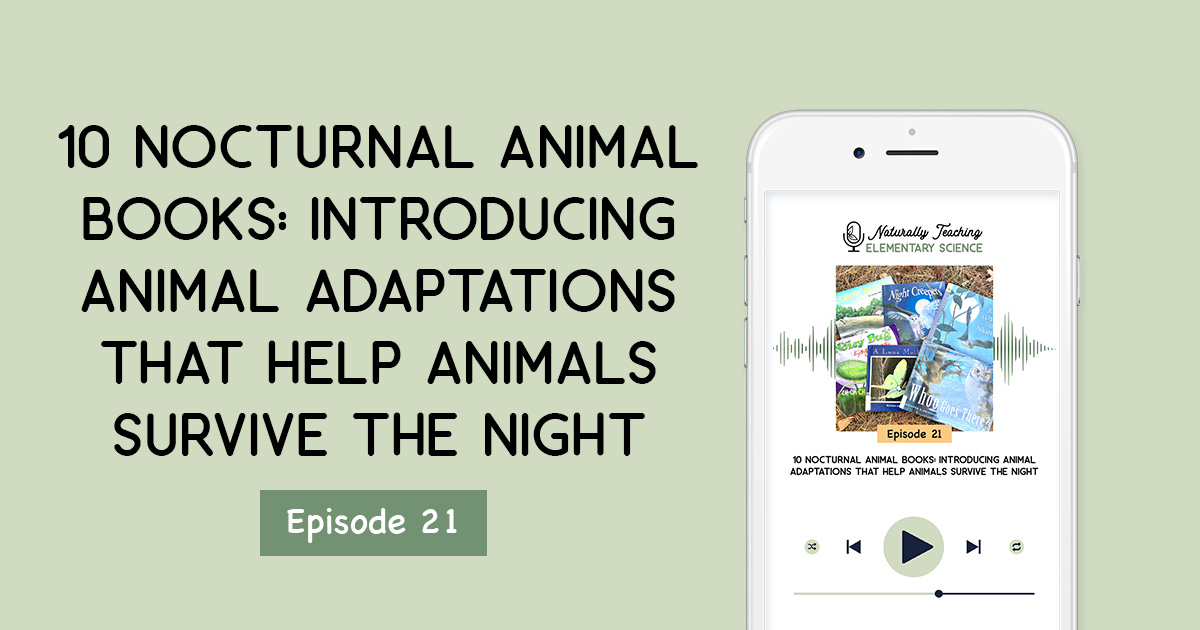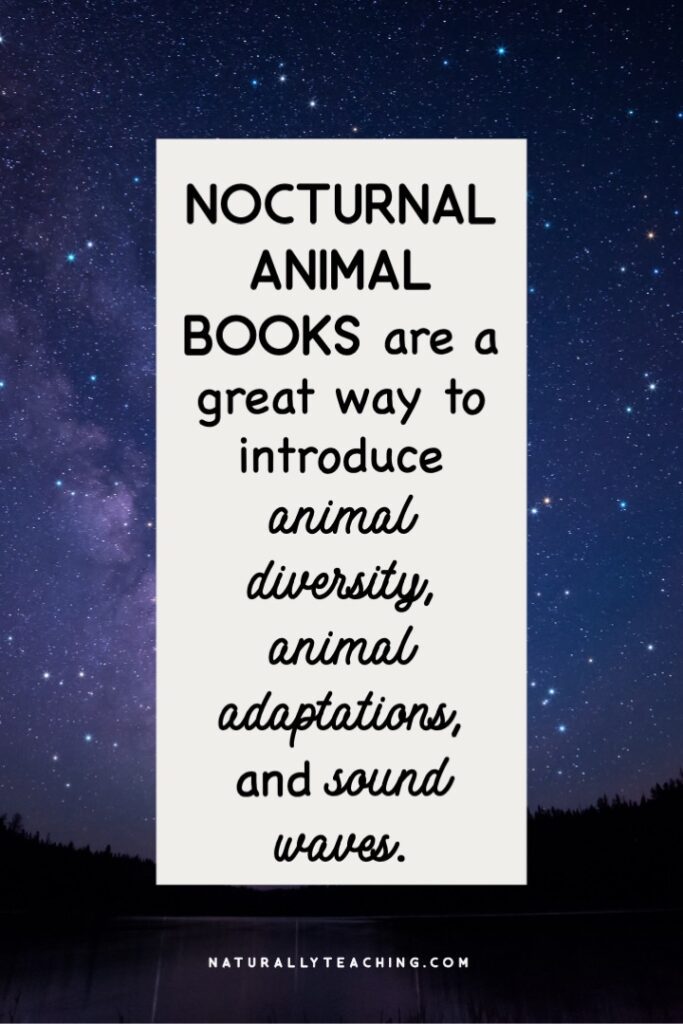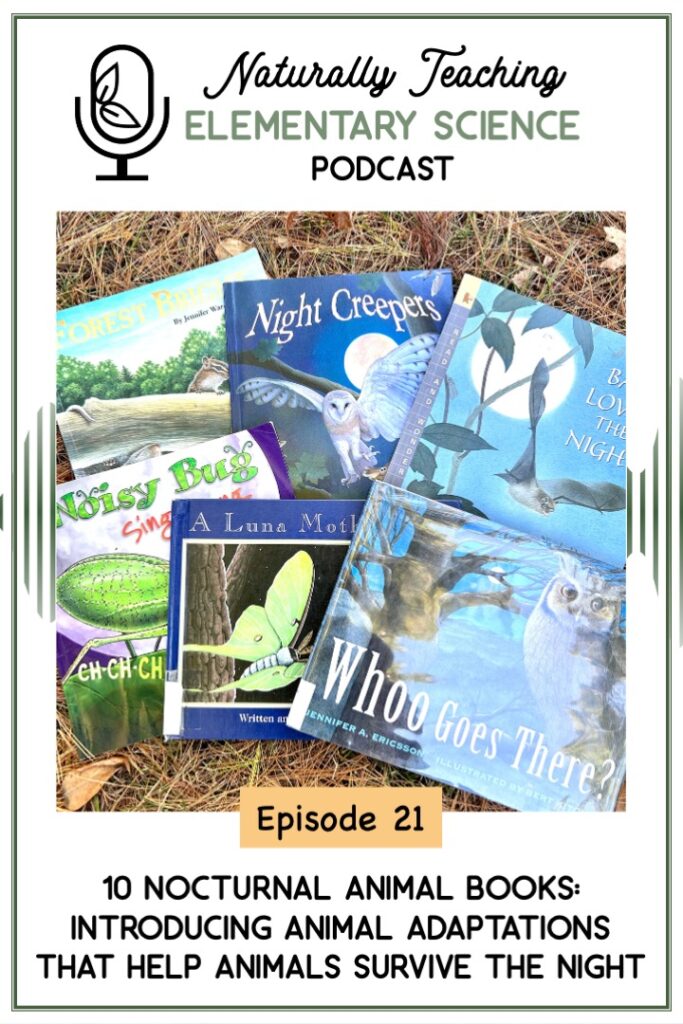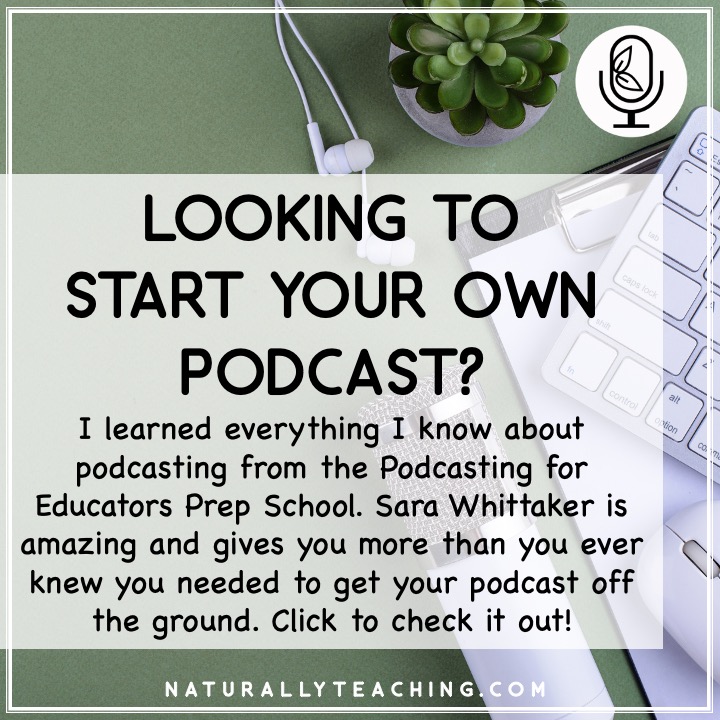Science
Frogs and Toads Together: Why do Amphibians Group Up?April 11, 2025


Affiliate disclosure: As an Amazon Associate, I may earn commissions from qualifying purchases from Amazon.com. This is at no extra cost to you. If you’d like to learn more, check out my disclaimers page.
Nocturnal animals are inherently interesting creatures and could be a great way to hook your students into your science studies this October. Bats, flying squirrels, raccoons, owls, moths, and more could grab your students’ attention, but many of them have never seen these creatures. Introduce them and their unique adaptations through picture books.
In this episode, I share 10 nocturnal animal books that you can use in your elementary classroom to introduce nocturnal animal diversity, adaptations, and sound waves. Listen in to discover some amazing nocturnal animal books to use this school year.
Nocturnal animal books covered in this episode include:
Have your students look closely at the illustrations in each picture book. A quality picture book will have every element extremely well thought out and the illustrations can tell you just as much as the text.

Affiliate Disclosure
I only endorse things that I’ve personally used, come highly recommended by trusted peers, or I’ve done extensive research on. As an Amazon Associate, I may earn commissions from qualifying purchases from Amazon.com. This is at no extra cost to you, the commission is covered by the company.
I am recommending products that I think will be genuinely helpful and useful, and not because of the small commissions that I receive. Please only purchase items if you believe that they will help you achieve your educational goals. If you’d like to learn more, check out my disclaimers page.
Teaching science in elementary school is crucial for nurturing young minds. But as educators, finding the time and resources to create engaging lessons can be a challenge. That's where this podcast comes in.
Welcome to Naturally Teaching Elementary Science, the show dedicated to supporting elementary teachers in their quest to bring authentic and place-based science experiences to their classroom. I'm Victoria Zablocki, a certified elementary teacher turned outdoor educator. With over a decade of experience coaching teachers on effective science teaching methods, I'm passionate about making science accessible, understandable, and fun for educators and students alike.
Join me as we explore strategies for teaching science in elementary school with practical teaching tips, insightful interviews, picture book reviews, and more. Whether you've taught for a long time or just started your teaching journey, this podcast is your trusty resource for enhancing your science curriculum. So let's grow together.
All right. Welcome back to the Naturally Teaching Elementary Science podcast. My name is Victoria Zablocki and I'm your host.
So we're currently in October and I wanted to share another topic that would intrigue your students during the spooky season and that topic is nocturnal animals. Although not inherently spooky, they're interesting and can get a lot of buzz going around in your classroom. So this week, what I'd like to do is to share summaries of 10 nocturnal animal books that will introduce your students to animal adaptations and sound waves through the lens of nocturnal animals.
So all of these books have nocturnal animals in common, but they can be broken down into three further categories. So the first category that we're going to delve into is the diversity of animals. So these first three books will provide your students with the opportunity to be introduced to a variety of animal species that are nocturnal, or animals that come out at night.
[2:04]
So to start us off, the first book is Little Owls Night by Divya Srinivasan. And this book introduces us to the typical nocturnal animal set that a lot of books will use. And so animals that she introduces us to are owl, who's the main character, snails, opossums, hedgehogs, skunks, beavers, fireflies, raccoons, moths, badgers, frogs, crickets, red foxes, bats, and she even throws in moonflowers.
This book has a very simplistic storyline and is a great option for introducing early childhood learners to nocturnal animals. The whole book takes place in the night, the pages are dark, and all of the cute forest animals pop against that black background.
And even though it's a simplistic storyline, this book has captivated my children from the time that they were about two, until even about seven years of age. And even as an adult, I love this cute little story. But if you're taking it to the classroom, it really is more appropriate for, say, your kindergarten or first grade students.
[3:11]
Book number two is Forest Bright, Forest Night by Jennifer Ward. And this story is literally one of my favorite stories, and it's a great one that can actually compare day animals, also known as diurnal animals, and night animals, also known as nocturnal animals.
So a lot of us are familiar with the word nocturnal. We've heard it many times. But diurnal is the opposite, so the animals that are coming out during the day. And so what I teach students is that diurnal is a word that starts with D, and also day starts with D. So our diurnal animals come out in the day, so D and D. And then our night animals, night starts with N, they're nocturnal, which also is an N word. And our nocturnal animals come out at night, N and N. So that could be a good mnemonic to be able to help your students remember nocturnal animals, diurnal animals.
Going back to the book though, if you get your hands on this book, you'll find that there's two different ways to read it. So one cover says Forest Bright, Forest Night, and this actually introduces your diurnal animals. So when you read it this way, the sun is coming up and then you see deer and you see snakes and a variety of animals that you could see awake during the day, but you're only halfway through the pages.
So what you have to do is you actually flip the whole book over, and then the other cover says Forest Night, Forest Bright, and that introduces your nocturnal animals. So the sun is going down and then it begins with owl and crickets, and provides you a variety of nocturnal animals to talk about. The Forest Night, Forest Bright ends when the sun is starting to come up.
So you can keep flipping it and reading it over and over if you'd like to. So some of the diurnal animals that are introduced are deer, bear, pileated woodpeckers, garter snakes, blue jays, red squirrels, chipmunks, turkeys, bees, and quail. And the nocturnal animals that are introduced are owls, porcupines, opossums, red foxes, skunks, salamanders, mice, beaver, crickets, and frogs.
And this book's illustrations are really rich with different clues to help your students better understand how both diurnal and nocturnal animals use the same space throughout the day. So even when you're reading it from the diurnal side, you can see where those nocturnal animals are and that they're sleeping through the day.
And then when you switch it and you're looking at your nocturnal animals, you can see that those diurnal animals are sleeping during the nighttime. So this book is kind of a step up from Little Owls Night, since it not only introduces nocturnal animals, but it also introduces diurnal animals as well. And as a side note, this book has a bit of an I Spy element.
So on each page, there are page numbers hidden, and the number of animals coordinates with that number. So on the first page, it introduces owl and deer, and there's only one owl and one deer, and the number one is on the page. So after you've read it a couple of times, tell your students that information, and see if they can find the numbers and then find the animals that coordinate with that number on each page.
It's a lot of fun, but I won't suggest doing it the first time you read it, because you want to get through the material. But once you've read it a few times, then introduce that and you could leave it as a center if you wanted, or you could try to do it together on a projector or in front of the class. It'll be a lot of fun.
[6:50]
Book number three is Daylight Starlight Wildlife by Wendell Minor. And this book is similar to Forest Bright, Forest Night in the sense that it introduces diurnal animals and nocturnal animals, but it does it in a different format. So this one will actually compare one to one by introducing a daylight animal first. And then on the next page, it introduces a nocturnal animal that is kind of equivalent.
So the diurnal animals that this book introduces are red-tailed hawk, but then it talks about the barn owl, and then it talks about cottontail rabbit, and then a opossum, and then tiger swallowtail butterfly, and paired with luna moth, and then a white-tailed deer, paired with a red fox. So it goes back and forth so that they can see these are the animals that would be awake during the day, but then this is something that's similar out in nature that's awake at night.
So this book ends with a spread of fun facts, which also includes the labels diurnal and nocturnal, and they throw in a bonus called crepuscular. So crepuscular is when an animal is out during those in-between times, the dawn and dusk time, when the sun is rising and the sun is setting. And so some of these animals that are introduced in the story are actually sometimes crepuscular and will come out during those in-between times to try to avoid predation. So that's kind of cool. This book is even a farther step up from Forest Bright, Forest Night by introducing a third time of the day that animals can be active.
[8:26]
All right, so book number four kind of falls into the first category of diversity of animals, but it also starts our second category of animal adaptations. So the fourth book is called Night Creepers by Linda Stanek. And this book follows a simple storyline, but it also has insets on each page to add more detail about the animal adaptations that allow each of the animals to survive at night. So this gives you choices on how much detail you want to include in your reading to your students.
So if you're reading for early childhood learners, you could read just the simple storyline. Or if you're reading for older students like fourth or fifth graders, you could also read the insets that have more facts about those animal adaptations. So the nocturnal animals that are covered in this book are red foxes, gray wolves, bats, flying squirrels, skunks, opossums, bullfrogs, fireflies, raccoons, owls, bobcats, and white-tailed deer.
And each spread is dedicated to a different nocturnal animal, and each inset goes into more details about that specific animal and their specific adaptations that let them survive through the night. So it's really rich, and the illustrations are fantastic, but the insets themselves are gold with their connection to animal adaptations.
[9:46]
Book number five is Where Are the Night Animals? by Mary Ann Fraser.
And this book is a more comprehensive book about nocturnal animals and their adaptations. So it's more of that nonfiction, really informative type book. It's likely more suitable for upper elementary students due to its vocabulary, length, and content.
So the nocturnal animals introduced in this book are coyotes, skunks, harvest mice, barn owls, opossums, raccoons, tree frogs, brown bats, moths, and mosquitoes. So this book also gives definitions for diurnal and nocturnal, explicitly lays it out there for the students in the actual text.
And it talks about a variety of animal adaptations. It literally calls it out in the text. So it talks about coloration and how that can help an animal survive at night, sensitive noses, and using different senses during a time of day when the animal can't see very well, how warnings can be given by smell, whiskers and their role in living at night, owls having ears that are asymmetrically placed, large eyes and their benefits, talons, and echolocation.
This book also touches on the potential reasons for an animal being nocturnal, like why are they out at night and not out during the day? Some of those potential reasons include that some animals get benefits from cooler and moister air, there's a lower competition between animals because there aren't as many animals awake at night, and there's lower predation, so there aren't as many animals awake, so there aren't as many things to be worried about eating you.
[11:26]
Book number six is A Luna Moth's Life by John Himmelman. This book is about the life cycle of the Luna Moth. The story begins in the night when a female Luna Moth lays eggs on a leaf, and then those eggs hatch, and the caterpillars spend the summer eating and growing fat. Then the caterpillar changes into a cocoon and stays that way during the wintertime. And in the spring, the moth emerges and dries out her wings. And then at night, she flies and releases pheromones out into the evening to attract a male moth, and then she mates with him and lays her own eggs.
So this book is a great option to discover the life cycle of a nocturnal animal as well as investigating the animal adaptation of pheromone release. So since nocturnal animals can't always rely on their sense of sight without a bright moon, many of them will rely on other senses. So female lunar moths use pheromones or a smelly chemical to let male moths know where they are in the dark so then they can reproduce and keep the species going.
[12:27]
Book number seven is Whoo Goes There? by Jennifer Ericsson. And this book is about a hungry owl that's trying to find his food one night. So he uses his heightened sense of hearing and his large eyes to try to decipher if an animal that's making noise is an appropriate meal for him. So it's kind of a guess who sort of book and that makes it fun and interactive for your students.
So this book doesn't explicitly say that owls have a heightened sense of hearing and great vision, but it's implied by the repetitive reference to hearing something moving in nature and watching with his big round eyes. So these two adaptations make it easier for owls to be able to find their food at night. And since the owl is looking for food, you could also include this book when you're studying food chains and webs in your class, not just animal adaptations.
[13:16]
All right, so book number eight falls into category two of animal adaptations, but it also bridges into our third category of sound waves. So book number eight is Bat Loves the Night by Nicola Davies. And this book is about a female pipistrelle bat, which is an insect eating bat. At night, she leaves the attic of the house she's living in with her baby, and she uses echolocation to navigate the forest and to find her food. When she returns to the house, she finds her battling and gives it milk.
So this book does a great job of explaining echolocation in a child-friendly way that can help your students understand how a bat can find food in the dark. This book has a narrative storyline to tell the experiences of the pipistrelle bat, but there's also insets on each of the different pages to provide facts, including things like the fact that bats aren't blind, and they could use their sense of sight if there was more light, but it's just easier for them to use sound to be able to navigate.
So those extra facts are again an opportunity for you to dive deeper into a certain subject if you want it, but you don't have to, you could just follow the simplistic narrative storyline.
I know that a lot of teachers like to use Stellaluna, it's a go-to for bat stories, but I absolutely love this book for teaching sound waves, for teaching echolocation, mammal characteristics, and animal needs. It's got it all. Most of the bats that we encounter in the United States are insect eating bats, whereas Stellaluna was a fruit eating bat. So I like to go to Bat Loves the Night, because it's about a bat that could be seen in our relative location here in Michigan. If you're interested in this book and you're looking for a great way to introduce sound waves to your students, you should check out my Sound Investigation Mini Unit for First Grade.
You could pair it with any fiction or nonfiction sound book, including Bat Loves the Night, and then participate in the ELA and science activities that encourage understanding of the story and the sound wave science concepts. Some of the activities that are included in this mini unit are recording evidence of story elements, a guided writing about sound, using verbs and nouns to finish sentences, investigating sounds in nature, designing a sound maker, building the sound maker, testing that sound maker, and then also analyzing the sound maker data that you collected. If you're interested in that, I'll make sure to link it in the show notes and you can find that at naturallyteaching.com/episode21.
[15:48]
Book number nine is also a sound wave book, so it's called Noisy Bug Sing-Along by John Himmelman. This book is about the different sounds that insects make, including field crickets, tree crickets, mole crickets, click beetles, tiger moths, cicadas, bumblebees, mosquitoes, katydids, and grasshoppers. Not all of these insects are nocturnal, but many of them are, and the illustrations make it pretty easy to identify which animals are nocturnal and which ones are diurnal.
And this book is interactive, which is fantastic, and it shares a quick fact about each insect, and then also the sound that it makes, which you can encourage your students to make as well. At the end of the book, Himmelman also provides you with the sound wave graphs of each of the animals, so that you can show your students what the insect sound waves actually look like. So, that's a really key piece of this book, is not only that you can make those sounds with your students, and they can feel the vibrations in their own bodies, but they can also see what those sound waves would look like if they were recorded and turned into a picture for them.
[16:59]
Book number 10 is Noisy Frog Sing-Along by John Himmelman. And this book follows the same framework as Noisy Bug Sing-Along, in the sense that it introduces different frog sounds with onomatopoeia words for your students to try out. So the frog species included in this book are spring peepers, green frogs, toads, bullfrogs, pickerel frogs, chorus frogs, mink frogs, spadefoot toads, and tree frogs.
Both Noisy Frog Sing-Along and Noisy Bug Sing-Along have a link at the back of their books that share the audio files with you and your students. So if you follow those links, you can actually get to recordings of these actual animals. Unfortunately, the Noisy Frog Sing-Along does not have the sound wave graphs like the Noisy Bug Sing-Along did, but both of them do have links at the back and also some activities that you can do around the animal species that were introduced in the books.
[17:58]
Something new I wanted to add to each episode is either a teaching tip, a nature note, or a science snippet. So today I want to include a teaching tip. When you're reading a picture book like these nocturnal animal books, have your students look closely at the illustrations.
There's just as much information provided in the illustrations as there are in the words. So as an example, the illustrations in Forest Bright, Forest Night by Jennifer Ward and illustrated by Jamichael Hunterly are incredibly rich and provide so much information to the reader.
If you look at the page with the red squirrels, Hunterly shows the squirrels gathering and hiding nuts like they would in the fall, as well as gathering mushrooms. And with that information alone, without any of the words on the page, you could talk with your students about the needs of the squirrels in the food chain.
And the picture also shows the salamanders sleeping under the leaves, which could bring up the conversation about shelter and where salamanders are during the day and why we don't see them. All of that is included literally just in the pictures. If you find a quality picture book, all aspects of that book are thought out and important. So make sure to take the time to have your students analyze everything. Pictures, words, the whole thing.
[19:17]
So in a nutshell, today we talked about 10 nocturnal animal books, including:
And don't forget, if you're looking for resources to help you introduce sound waves to your students, check out the Sound investigation Mini Unit for First Grade in my Teachers Pay Teachers Store. Thanks for taking the time to listen today.
I know you're busy, and I truly appreciate the time you take to tune in. If you have any questions, wonderings, or nocturnal animal books that you use, get ahold of me on Instagram at Naturally.Teaching, or you can email me at victoria@naturallyteaching.com. Thanks again for joining me today, and until next time, keep exploring, keep learning, and keep Naturally Teaching.
Thank you so much for tuning in to today's episode of the Naturally Teaching Elementary Science podcast. I hope you found it informative, inspiring, and full of actionable insights to enhance your science teaching journey. Connect with me on social media for more updates, science tidbits, and additional resources.
You can find me on Instagram and Facebook at naturally.teaching. Let's continue the conversation and share our passion for elementary science education together. Don't forget to visit my website at naturallyteaching.com for all the show notes from today's episode.
If you enjoyed today's episode, please consider leaving a review on your favorite podcast platform. Your feedback helps me improve and reach more educators just like you. Thank you again for listening, and until next time, keep exploring, keep learning, and keep naturally teaching.


0